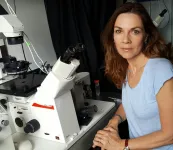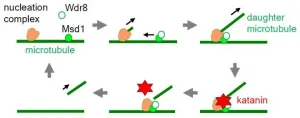(Press-News.org) Like the movie version of Spider-Man who shoots spider webs from holes in his wrists, a little alpine plant has been found to eject cobweb-like threads from tiny holes in specialised cells on its leaves. It's these tiny holes that have taken plant scientists by surprise because puncturing the surface of a plant cell would normally cause it to explode like a water balloon.
The small perennial cushion-shaped plant with bright yellow flowers, Dionysia tapetodes, is in the primula family and naturally occurs in Turkmenistan and north-eastern Iran, and through the mountains of Afghanistan to the border of Pakistan. What makes it unusual is its leaves, which are covered in long silky fibres that resemble fine cobwebs called 'woolly farina'.
Quite a few of its primula relatives have leaves coated with a fine powder consisting almost entirely from flavone, which is a class of flavonoid. Flavonoids are small specialised molecules involved in plant metabolism and are recognised for their anti-inflammatory and antioxidant properties. But this Dionysia species does not have flavone powder on its leaves, instead it has very fine wool just 1-2 microns thick - far thinner than a human hair, which is about 75 microns.
As part of an ongoing collaboration between the University of Cambridge's plant science research institute Sainsbury Laboratory Cambridge University (SLCU) and Cambridge University Botanic Garden (CUBG), Dionysia was selected from the Botanic Garden's living collection of 8,000 cultivated plant species to be analysed at SLCU's Microscopy Core Facilities.
"The woolly farina threads seem to cover the entire leaf surface with long threads even connecting leaf-to-leaf," said Paul Aston, who is the Botanic Garden Alpine and Woodland Supervisor. "Nobody knew what this wool was or how it was made and so we thought that this would be an interesting specimen to study. There are many things that plants make that we do not yet know about - this is especially true for alpine plants where we see many unusual adaptations to the harsh high altitude environments they live in."
Samples were analysed using advanced light and electron microscopes, which revealed the micron-diameter wool had distinct parallel grooves running along their length. But the most surprising observation was how the wool was emerging from the leaves.
"The leaves are covered in tiny hairs called trichomes. Each trichome has a spherical shaped glandular cell at the end - like a stalk with a single round cell at the tip - and we could see the threads emerging straight out of the glandular cell," said Dr Raymond Wightman, who is the Microscopy Core Facility Manager in the University of Cambridge's Sainsbury Laboratory. "But we know that plant cells are surrounded by a cell wall that protects and retains pressure within the cell. Poking holes through the cell membrane and cell wall would cause the cell to burst - like puncturing a water balloon."
So how were the threads getting out without exploding the cell?
Using a powerful electron microscope at the Cambridge Advanced Imaging Centre (CAIC), they sectioned the glandular cells and when they zoomed in could see tiny gaps in the cells just large enough to thread a single woolly farina fibre through.
"The plant manufactures the fibre inside the cell and then threads it through the gaps that are just wide enough for it," said Dr Matthieu Bourdon who is a researcher at SLCU and co author of the report published in BMC Plant Biology. "There is a distinct opening in the plasma membrane, cell wall and cuticle creating a hole that forms a tight seal around the fibre - we could even see wax on the cell surface acting like a plug to seal any gaps. We observed multiple fibres being extruded from individual glandular cells at specific spots across its surface. The plant must be concentrating the flavone building blocks within the cells at these specific exit sites to be able to produce the elongating fibre."
Dr Wightman also analysed the chemistry of the fibres to find what they are made from using the Institute's Raman microscope, but the wool's complex structure required further analysis using specialist equipment and skills from the University's Yusuf Hamied Department of Chemistry.
"The analysis of the woolly farina sample was challenging because of the small size of the sample and the similarity of the chemicals that it was made up of, said Dr Josephine Gaynord, PhD graduate from the University of Cambridge's Department of Chemistry and who undertook the further analysis using advanced chromatography, mass spectrometry and nuclear magnetic resonance (NMR) spectroscopy techniques. "It helped that we knew the majority of the sample was flavone, a chemical that we could buy and compare to the woolly farina sample. Thanks to some excellent support from the NMR team in the Department of Chemistry we were able to run bespoke analysis and provide possible structures for the modified flavones that were present. It would be very interesting to follow this work up in the future."
Wightman said they were expecting the fibres to be made up of flavonoids similar to the powdery coating on the leaves of some other primula species, but were intrigued by how this species was able to turn flavones into such stable wool-like fibres. "We found the wool produced by Dionysia tapetodes has a special chemical structure that is a mix of flavone and flavone derivatives that may use hydrogen bonding between molecules to form the elongated fibres. This means inside the cell these flavones need to be mixed precisely while being added to the end of the fibre so that they exit the gap as one continuous thread - like squeezing a continuous line of toothpaste from a tube."
"While it is not known what purpose the woolly farina serves, it is thought it could be a protective measure offering tolerance to freezing, drought and/or blocking high UV," said Simon Wallis, Alpine and Woodland Assistant at CUBG. "This latter theory is supported by observations that we have made from our alpine collection, comparing the wool-producing Dionysia tapetodes with a subset of Dionysia tapetodes that do not have woolly farina and are more susceptible to sun scorching."
The team is interested in further exploring the properties of these fibres to determine if they might be a useful biomaterial.
INFORMATION:
A team of scientists using the Atacama Large Millimeter/submillimeter Array (ALMA) to study the young star Elias 2-27 have confirmed that gravitational instabilities play a key role in planet formation, and have for the first time directly measured the mass of protoplanetary disks using gas velocity data, potentially unlocking one of the mysteries of planet formation. The results of the research are published today in two papers in The Astrophysical Journal.
Protoplanetary disks--planet-forming disks made of gas and dust that surround newly formed young stars--are ...
Ocean currents sometimes pinch off sections that create circular currents of water called "eddies." This "whirlpool" motion moves nutrients to the water's surface, playing a significant role in the health of the Florida Keys coral reef ecosystem.
Using a numerical model that simulates ocean currents, researchers from Florida Atlantic University's Harbor Branch Oceanographic Institute and collaborators from the Alfred-Wegener-Institute in Germany and the Institut Universitaire Europeen De La Mer/Laboratoire d'Océonographie Physique et Spatiale in France are shedding light on this important "motion of the ocean." They have conducted a first-of-its-kind study identifying ...
Researchers at the National Institutes of Health have developed a prototype device that could potentially diagnose pregnancy complications by monitoring the oxygen level of the placenta. The device sends near-infrared light through the pregnant person's abdomen to measure oxygen levels in the arterial and venous network in the placenta. The method was used to study anterior placenta, which is attached to the front wall of the uterus. The researchers described their results as promising but added that further study is needed before the device could be used routinely.
The small study was conducted by Amir Gandjbakhche, Ph.D., of the Section on Translational Biophotonics at NIH's Eunice Kennedy Shriver National Institute ...
People--who get lost easily in the extraordinary darkness of a tropical forest--have much to learn from a bee that can find its way home in conditions 10 times dimmer than starlight. Researchers at the Smithsonian Tropical Research Institute's (STRI) research station on Barro Colorado Island in Panama and the University of Lund in Sweden reveal that sweat bees (Megalopta genalis), find their way home based on patterns in the canopy overhead using dorsal vision. This first report of dorsal navigation in a flying insect, published in Current Biology, may be of special interest to makers of drones and other night-flying vehicles.
"One of the pioneers of studies on homing behaviors in bees was Charles H. Turner, an African-American scientist from the University ...
Bacteria do not sexually reproduce, but that does not stop them from exchanging genetic information as it evolves and adapts. During conjugal transfer, a bacterium can connect to another bacterium to pass along DNA and proteins. Escherichia coli bacteria, commonly called E. coli, can transfer at least one of these gene-containing plasmids to organisms across taxonomic kingdoms, including to fungi and protists. Now, researchers from Hiroshima University have a better understanding of this genetic hat trick, which has potential applications as a tool to promote desired characteristics or suppress harmful ones across genetic hosts.
They published their results on ...
Young people with poor mental health took a turn for the better during the pandemic but those with good mental health saw a considerable decline, new research reveals.
The first nationally representative evidence regarding the diverse impact of the COVID-19 pandemic on adolescent mental health in the UK was led by researchers at Lancaster University working with the University of British Columbia in Canada.
Adolescents (aged 10 to 16) with better than average mental health before the pandemic experienced an increase in their emotional and conduct problems, hyperactivity, and problems interacting with their peers and friends, but a decrease in their prosocial ...
Scientists have identified key molecular events in the developing human embryo between days 7 and 14 - one of the most mysterious, yet critical, stages of our development.
The second week of gestation represents a critical stage of embryo development, or embryogenesis. Failure of development during this time is one of the major causes of early pregnancy loss. Understanding more about it will help scientists to understand how it can go wrong, and take steps towards being able to fix problems.
The pre-implantation period, before the developing embryo implants into the mother's womb, has been studied extensively in human embryos ...
Ikoma, Japan - The katana, a Japanese sword, may be thought of solely as a weapon used by the samurai. But researchers from Japan have discovered that not only do plants wield their own katanas within their cells, they recruit them to specific locations within those cells to do their work.
In a study published in Nature Communications, researchers from Nara Institute of Science and Technology have revealed that the enzyme katanin, which is named after the katana, is used by an anchoring complex to cut microtubules at specific locations of the framework within individual plant cells.
Katanin ...
NEW YORK (June 17, 2021)--New York City neighborhoods that had higher levels of socioeconomic disadvantage experienced more COVID-19 infections and deaths, according to Mount Sinai scientists who created a neighborhood-level COVID-19 inequity index.
The index measured factors that fueled inequities in the residents' lives, such as employment and commuting patterns, population density of their neighborhood, food access, socioeconomic status, and access to health care. This allowed the scientists to compare between neighborhoods the contributions of these social factors in facilitating disease transmission during the first wave of the pandemic in a study published in Nature Communications in June.
"Much of the early rhetoric around COVID-19 ...
As almost all our private information is digitalized, it is increasingly important that we find ways to protect our data and ourselves from being hacked.
Quantum Cryptography is the researchers' answer to this problem, and more specifically a certain kind of qubit - consisting of single photons: particles of light.
Single photons or qubits of light, as they are also called, are extremely difficult to hack.
However, in order for these qubits of light to be stable and work properly they need to be stored at temperatures close to absolute zero - that is minus ...






